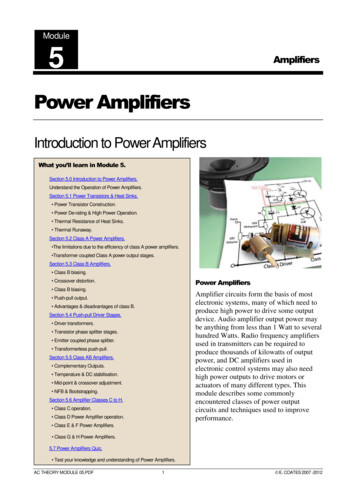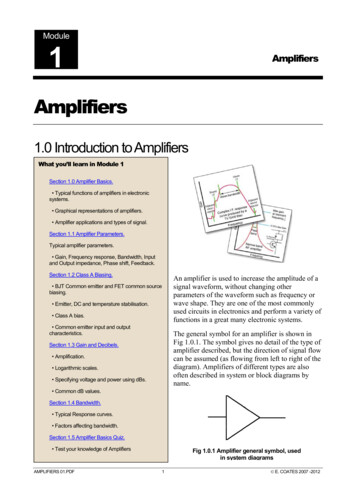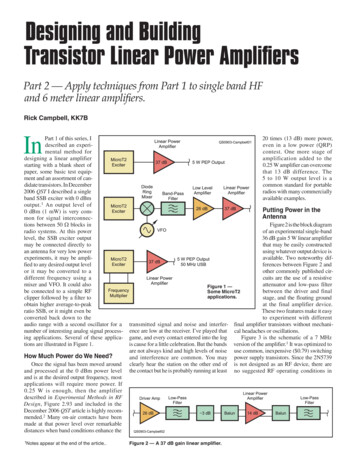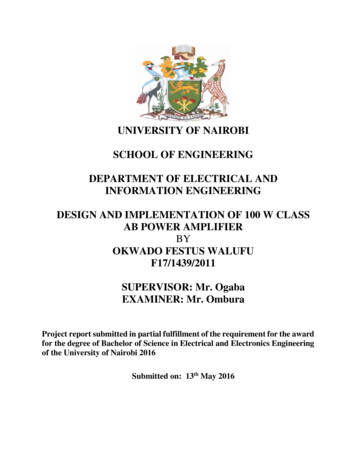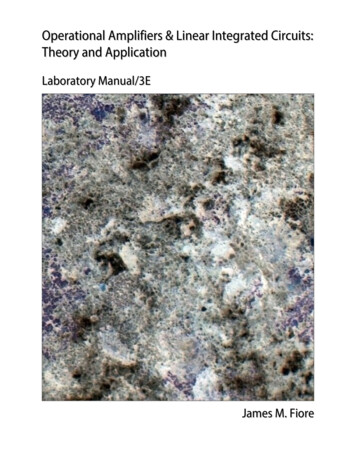
Transcription
Nagel, J. H. “Biopotential Amplifiers.”The Biomedical Engineering Handbook: Second Edition.Ed. Joseph D. BronzinoBoca Raton: CRC Press LLC, 2000
70Biopotential Amplifiers70.1Basic Amplifier RequirementsInterferences70.2Joachim H. NagelUniversity of StuttgartSpecial CircuitsInstrumentation Amplifier Isolation Amplifier and PatientSafety Surge Protection Input Guarding DynamicRange and Recovery Passive Isolation Amplifiers DigitalElectronicsBiosignals are recorded as potentials, voltages, and electrical field strengths generated by nerves andmuscles. The measurements involve voltages at very low levels, typically ranging between 1 µV and100 mV, with high source impedances and superimposed high level interference signals and noise. Thesignals need to be amplified to make them compatible with devices such as displays, recorders, or A/Dconverters for computerized equipment. Amplifiers adequate to measure these signals have to satisfy veryspecific requirements. They have to provide amplification selective to the physiological signal, rejectsuperimposed noise and interference signals, and guarantee protection from damages through voltageand current surges for both patient and electronic equipment. Amplifiers featuring these specificationsare known as biopotential amplifiers. Basic requirements and features, as well as some specialized systems,will be presented.70.1 Basic Amplifier RequirementsThe basic requirements that a biopotential amplifier has to satisfy are: the physiological process to be monitored should not be influenced in any way by the amplifierthe measured signal should not be distortedthe amplifier should provide the best possible separation of signal and interferencesthe amplifier has to offer protection of the patient from any hazard of electrical shockthe amplifier itself has to be protected against damages that might result from high input voltagesas they occur during the application of defibrillators or electrosurgical instrumentationA typical configuration for the measurement of biopotentials is shown in Fig. 70.1. Three electrodes,two of them picking up the biological signal and the third providing the reference potential, connect thesubject to the amplifier. The input signal to the amplifier consists of five components: (1) the desiredbiopotential, (2) undesired biopotentials, (3) a power line interference signal of 60 Hz (50 Hz in somecountries) and its harmonics, (4) interference signals generated by the tissue/electrode interface, and(5) noise. Proper design of the amplifier provides rejection of a large portion of the signal interferences.The main task of the differential amplifier as shown in Fig. 70.1 is to reject the line frequency interferencethat is electrostatically or magnetically coupled into the subject. The desired biopotential appears as avoltage between the two input terminals of the differential amplifier and is referred to as the differential 2000 by CRC Press LLC
FIGURE 70.1 Typical configuration for the measurement of biopotentials. The biological signal Vbiol appearsbetween the two measuring electrodes at the right and left arm of the patient, and is fed to the inverting and thenon-inverting inputs of the differential amplifier. The right leg electrode provides the reference potential for theamplifier with a common mode voltage Vc as indicated.signal. The line frequency interference signal shows only very small differences in amplitude and phasebetween the two measuring electrodes, causing approximately the same potential at both inputs, andthus appears only between the inputs and ground and is called the common mode signal. Strong rejectionof the common mode signal is one of the most important characteristics of a good biopotential amplifier.The common mode rejection ratio (or CMRR) of an amplifier is defined as the ratio of the differentialmode gain over the common mode gain. As seen in Fig. 70.1, the rejection of the common mode signalin a biopotential amplifier is both a function of the amplifier CMRR and the source impedances Z1 andZ2 . For the ideal biopotential amplifier with Z1 Z2 and infinite CMRR of the differential amplifier, theoutput voltage is the pure biological signal amplified by GD, the differential mode gain: Vout GD ·Vbiol .With finite CMRR, the common mode signal is not completely rejected, adding the interference termGD ·Vc /CMRR to the output signal. Even in the case of an ideal differential amplifier with infinite CMRR,the common mode signal will not completely disappear unless the source impedances are equal. Thecommon mode signal Vc causes currents to flow through Z1 and Z2 . The related voltage drops show adifference if the source impedances are unequal, thus generating a differential signal at the amplifierinput which, of course, is not rejected by the differential amplifier. With amplifier gain GD and inputimpedance Z in, the output voltage of the amplifier is:Vout GDVbiol GDVcZ in GDVc 1 CMRR Z in Z1 Z 2 (70.1)The output of a real biopotential amplifier will always consist of the desired output component dueto a differential biosignal, an undesired component due to incomplete rejection of common modeinterference signals as a function of CMRR, and an undesired component due to source impedanceunbalance allowing a small proportion of a common mode signal to appear as a differential signal to theamplifier. Since source impedance unbalances of 5,000 to 10,000 Ω , mainly caused by electrodes, are notuncommon, and sufficient rejection of line frequency interferences requires a minimum CMRR of 100 dB,the input impedance of the amplifier should be at least 109 Ω at 60 Hz to prevent source impedanceunbalances from deteriorating the overall CMRR of the amplifier. State-of-the-art biopotential amplifiersprovide a CMRR of 120 to 140 dB.In order to provide optimum signal quality and adequate voltage level for further signal processing,the amplifier has to provide a gain of 100 to 50,000 and needs to maintain the best possible signal-tonoise ratio. The presence of high level interference signals not only deteriorates the quality of thephysiological signals, but also restricts the design of the biopotential amplifier. Electrode half-cell potentials, for example, limit the gain factor of the first amplifier stage since their amplitude can be severalorders of magnitude larger than the amplitude of the physiological signal. To prevent the amplifier from 2000 by CRC Press LLC
FIGURE 70.2 Schematic design of the main stages of a biopotential amplifier. Three electrodes connect the patientto a preamplifier stage. After removing dc and low-frequency interferences, the signal is connected to an output lowpass filter through an isolation stage which provides electrical safety to the patient, prevents ground loops, andreduces the influence of interference signals.going into saturation, this component has to be eliminated before the required gain can be provided forthe physiological signal.A typical design of the various stages of a biopotential amplifier is shown in Fig. 70.2. The electrodeswhich provide the transition between the ionic flow of currents in biological tissue and the electronicflow of current in the amplifier, represent a complex electrochemical system that is described elsewherein this handbook. The electrodes determine to a large extent the composition of the measured signal.The preamplifier represents the most critical part of the amplifier itself since it sets the stage for thequality of the biosignal. With proper design, the preamplifier can eliminate, or at least minimize, mostof the signals interfering with the measurement of biopotentials.In addition to electrode potentials and electromagnetic interferences, noise—generated by the amplifierand the connection between biological source and amplifier—has to be taken into account when designingthe preamplifier. The total source resistance Rs, including the resistance of the biological source and alltransition resistances between signal source and amplifier input, causes thermal voltage noise with a rootmean square (rms) value of:Erms 4kTRs B(Volt )(70.2)where k Boltzmann constant, T absolute temperature, Rs resistance in Ω , and B bandwidth in Hz.Additionally, there is the inherent amplifier noise. It consists of two frequency-dependent components,the internal voltage noise source en and the voltage drop across the source resistance Rs caused by aninternal current noise generator in . The total input noise for the amplifier with a bandwidth of B f2 –f1 is calculated as the sum of its three independent components:f2 f2 2Erms en2df Rs2 in2df 4kTRs Bf1(70.3)f1High signal-to-noise ratios thus require the use of very low noise amplifiers and the limitation ofbandwidth. Current technology offers differential amplifiers with voltage noise of less than 10 nV/ Hzand current noise less than 1 pA/ Hz . Both parameters are frequency dependent and decrease approximately with the square root of frequency. The exact relationship depends on the technology of theamplifier input stage. Field effect transistor (FET) preamplifiers exhibit about five times the voltage noisedensity compared to bipolar transistors but a current noise density that is about 100 times smaller. 2000 by CRC Press LLC
The purpose of the high pass and low pass filters in Fig. 70.2 is to eliminate interference signals likeelectrode half-cell potentials and preamplifier offset potentials and to reduce the noise amplitude by thelimitation of the amplifier bandwidth. Since the biosignal should not be distorted or attenuated, higherorder sharp-cutting linear phase filters have to be used. Active Bessel filters are preferred filter types dueto their smooth transfer function. Separation of biosignal and interference is in most cases incompletedue to the overlap of their spectra.The isolation stage serves the galvanic decoupling of the patient from the measuring equipment andprovides safety from electrical hazards. This stage also prevents galvanic currents from deteriorating thesignal-to-noise ratio especially by preventing ground loops. Various principles can be used to realize theisolation stage. Analog isolation amplifiers use either transformer, optical, or capacitive couplers totransmit the signal through the isolation barrier. Digital isolation amplifiers use a voltage/frequencyconverter to digitize the signal before it is transmitted easily by optical or inductive couplers to the outputfrequency/voltage converter. The most important characteristics of an isolation amplifier are low leakagecurrent, isolation impedance, isolation voltage (or mode) rejection (IMR), and maximum safe isolationvoltage.InterferencesThe most critical point in the measurement of biopotentials is the contact between electrodes andbiological tissue. Both the electrode offset potential and the electrode/tissue impedance are subject tochanges due to relative movements of electrode and tissue. Thus, two interference signals are generatedas motion artifacts: the changes of the electrode potential and motion-induced changes of the voltagedrop caused by the input current of the preamplifier. These motion artifacts can be minimized byproviding high input impedances for the preamplifier, usage of non-polarized electrodes with low halfcell potentials such as Ag/AgCl electrodes, and by reducing the source impedance by use of electrode gel.Motion artifacts, interferences from external electromagnetic fields, and noise can also be generated inthe wires connecting electrodes and amplifier. Reduction of these interferences is achieved by usingtwisted pair cables, shielded wires, and input guarding.Recording of biopotentials is often done in an environment that is equipped with many electricalsystems which produce strong electrical and magnetic fields. In addition to 60 Hz power line frequencyand some strong harmonics, high frequency electromagnetic fields are encountered. At power linefrequency, the electric and magnetic components of the interfering fields can be considered separately.Electrical fields are caused by all conductors that are connected to power, even with no flow of current.A current is capacitively coupled into the body where it flows to the ground electrode. If an isolationamplifier is used without patient ground, the current is capacitively coupled to ground. In this case, thebody potential floats with a voltage of up to 100 V towards ground. Minimizing interferences requiresincreasing the distance between power lines and the body, use of isolation amplifiers, separate groundingof the body at a location as far away from the measuring electrodes as possible, and use of shieldedelectrode cables.The magnetic field components produce eddy currents in the body. The amplifier, the electrode cable,and the body form an induction loop that is subject to the generation of an interference signal. Minimizingthis interference signal requires increasing the distance between the interference source and patient,twisting the connecting cables, shielding of the magnetic fields, and relocating the patient to a place andorientation that offers minimum interference signals. In many cases, an additional narrow band-rejectionfilter (notch filter) is implemented as an additional stage in the biopotential amplifier to provide sufficientsuppression of line frequency interferences.In order to achieve optimum signal quality, the biopotential amplifier has to be adapted to the specificapplication. Based on the signal parameters, both appropriate bandwidth and gain factor are chosen.Figure 70.3 shows an overview of the most commonly measured biopotentials and specifies the normalranges for amplitude and bandwidth. 2000 by CRC Press LLC
FIGURE 70.3 Amplitudes and spectral ranges of some important biosignals. The various biopotentials completelycover the area from 10–6 V to almost 1 V and from dc to 10 kHz.A final requirement for biopotential amplifiers is the need for calibration. Since the amplitude of thebiopotential often has to be determined very accurately, there must be provisions to easily determine thegain or the amplitude range referenced to the input of the amplifier. For this purpose, the gain of theamplifier must be well calibrated. In order to prevent difficulties with calibrations, some amplifiers thatneed to have adjustable gain use a number of fixed gain settings rather than providing a continuous gaincontrol. Some amplifiers have a standard signal source of known amplitude built in that can be momentarily connected to the input by the push of a button to check the calibration at the output of thebiopotential amplifier.70.2 Special CircuitsInstrumentation AmplifierAn important stage of all biopotential amplifiers is the input preamplifier which substantially contributesto the overall quality of the system. The main tasks of the preamplifier are to sense the voltage betweentwo measuring electrodes while rejecting the common mode signal, and minimizing the effect of electrodepolarization overpotentials. Crucial to the performance of the preamplifier is the input impedance whichshould be as high as possible. Such a differential amplifier cannot be realized using a standard singleoperational amplifier (op-amp) design since this does not provide the necessary high input impedance.The general solution to the problem involves voltage followers, or noninverting amplifiers, to attain highinput impedances. A possible realization is shown in Fig. 70.4a. The main disadvantage of this circuit isthat it requires high CMRR both in the followers and in the final op-amp. With the input buffers workingat unity gain, all the common-mode rejection must be accomplished in the output amplifier, requiringvery precise resistor matching. Additionally, the noise of the final op-amp is added at a low signal level, 2000 by CRC Press LLC
FIGURE 70.4 Circuit drawings for three different realizations of instrumentation amplifiers for biomedical applications. Voltage follower input stage (a), improved, amplifying input stage (b), and 2-op-amp version (c).decreasing the signal-to-noise ratio unnecessarily. The circuit in Fig. 70.4b eliminates this disadvantage.It represents the standard instrumentation amplifier configuration. The two input op-amps provide highdifferential gain and unity common-mode gain without the requirement of close resistor matching. Thedifferential output from the first stage represents a signal with substantial relative reduction of thecommon-mode signal and is used to drive a standard differential amplifier which further reduces thecommon-mode signal. CMRR of the output op-amp as well as resistor matching in its circuit are lesscritical than in the follower type instrumentation amplifier. Offset trimming for the whole circuit canbe done at one of the input op-amps. Complete instrumentation amplifier integrated circuits based onthis standard instrumentation amplifier configuration are available from several manufacturers. Allcomponents except R1, which determines the gain of the amplifier, and the potentiometer for offsettrimming are contained on the integrated circuit chip. Figure 70.4c shows another configuration thatoffers high input impedance with only two op-amps. For good CMRR, however, it requires precise resistormatching.In applications where DC and very low frequency biopotentials are not to be measured, it would bedesirable to block those signal components at the preamplifier inputs by simply adding a capacitorworking as a passive high-pass filter. This would eliminate the electrode offset potentials and permit ahigher gain factor for the preamplifier and thus a higher CMRR. A capacitor between electrodes andamplifier input would, however, result in charging effects from the input bias current. Due to the difficultyof precisely matching capacitors for the two input leads, they would also contribute to an increased sourceimpedance unbalance and thus reduce CMRR. Avoiding the problem of charging effects by adding aresistor between the preamplifier inputs and ground as shown in Fig. 70.5a also results in a decrease ofCMRR due to the diminished and mismatched input impedance. A 1% mismatch for two 1-MΩ resistorsFIGURE 70.5 AC coupled instrumentation amplifier designs. The classical design using an RC high-pass filter atthe inputs (a), and a high CMRR “quasi-high-pass” amplifier as proposed by Lu (b). 2000 by CRC Press LLC
can already create a –60 dB loss in CMRR. The lossin CMRR is much greater if the capacitors are mismatched, which cannot be prevented in real systems.Nevertheless, such realizations are used where thespecific situation allows. In some applications, a further reduction of the amplifier to a two-electrodeamplifier configuration would be convenient, evenat the expense of some loss in the CMRR. Figure 70.6shows a preamplifier design working with two electrodes and providing AC coupling as proposed byPallás-Areny [1990].A third alternative of eliminating DC and lowfrequencies in the first amplifier stage is a directlycoupled quasi-high-pass amplifier design, whichmaintains the high CMRR of DC coupled high inputimpedance instrumentation amplifiers [Song et al.,1998]. In this design, the gain determining resistorR1 (Fig. 70.5a) is replaced by a first order high-passfilter consisting of R1 and a series capacitor Cf . Thesignal gain of the amplifier isG 1 FIGURE 70.6 Composite instrumentation amplifierbased on an ac-coupled first stage. The second stage isbased on a one op-amp differential amplifier which canbe replaced by an instrumentation amplifier.2R21R1 jωC(70.4)Thus, DC gain is 1, while the high frequency gain remains at G 1 2R2/R1. A realization using an offthe-shelf instrumentation amplifier (Burr-Brown INA 118) operates at low power (0,35 mA) with lowoffset voltage (11 µV typical) and low input bias current (1 nA typical), and offers a high CMRR of118 dB at a gain of G 50. The very high input impedance (10 GΩ) of the instrumentation amplifierrenders it insensitive to fluctuations of the electrode impedance. Therefore, it is suitable for bioelectricmeasurements using pasteless electrodes applied to unprepared, i.e., high impedance skin.The preamplifier, often implemented as a separate device which is placed close to the electrodes oreven directly attached to the electrodes, also acts as an impedance converter which allows the transmissionof even weak signals to the remote monitoring unit. Due to the low output impedance of the preamplifier,the input impedance of the following amplifier stage can be low, and still the influence of interferencesignals coupled into the transmission lines is reduced.Isolation Amplifier and Patient SafetyIsolation amplifiers can be used to break ground loops, eliminate source ground connections, and provideisolation protection to patient and electronic equipment. In a biopotential amplifier, the main purposeof the isolation amplifier is the protection of the patient by eliminating the hazard of electric shockresulting from the interaction among patient, amplifier, and other electric devices in the patient’s environment, specifically defibrillators and electrosurgical equipment. It also adds to the prevention of linefrequency interferences.Isolation amplifiers are realized in three different technologies: transformer isolation, capacitor isolation, and opto-isolation. An isolation barrier provides a complete galvanic separation of the input side,i.e., patient and preamplifier, from all equipment on the output side. Ideally, there will be no flow ofelectric current across the barrier. The isolation-mode voltage is the voltage which appears across theisolation barrier, i.e., between the input common and the output common (Fig. 70.7). The amplifier hasto withstand the largest expected isolation voltages without damage. Two isolation voltages are specified 2000 by CRC Press LLC
FIGURE 70.7 Equivalent circuit of an isolation amplifier. The differential amplifier on the left transmits the signalthrough the isolation barrier by a transformer, capacitor, or an opto-coupler.for commercial isolation amplifiers: (1) the continuous rating and (2) the test voltage. To eliminate theneed for longtime testing, the device is tested at about two times the rated continuous voltage. Thus, fora continuous rating of 2000 V, the device has to be tested at 4000 to 5000 V for a reasonable period of time.Since there is always some leakage across the isolation barrier, the isolation mode rejection ratio(IMRR) is not infinite. For a circuit as shown in Fig. 70.7, the output voltage is:Vout GRG1 RG2 RIN VV VD CM ISOCMRR IMRR (70.5)where G is the amplifier gain, VD, VCM , and VISO are differential, common mode, and isolation voltages,respectively, and CMRR is the common mode rejection ratio for the amplifier [Burr-Brown, 1994].Typical values of IMRR for a gain of 10 are 140 dB at DC, and 120 dB at 60 Hz with a source unbalanceof 5000 Ω . The isolation impedance is approximately 1.8 pF 1012 Ω .Transformer coupled isolation amplifiers perform on the basis of inductive transmission of a carriersignal that is amplitude modulated by the biosignal. A synchronous demodulator on the output portreconstructs the signal before it is fed through a Bessel response low-pass filter to an output buffer. Apower transformer, generally driven by a 400 to 900 kHz square wave, supplies isolated power to theamplifier.Optically coupled isolation amplifiers can principally be realized using only a single LED and photodiode combination. While useful for a wide range of digital applications, this design has fundamentallimitations as to its linearity and stability as a function of time and temperature. A matched photodiodedesign, as used in the Burr-Brown 3650/3652 isolation amplifier, overcomes these difficulties [BurrBrown, 1994]. Operation of the amplifier requires an isolated power supply to drive the input stages.Transformer coupled low leakage current isolated DC/DC converters are commonly used for this purpose.In some particular applications, especially in cases where the signal is transmitted over a longer distanceby fiber optics, e.g., ECG amplifiers used for gated magnetic resonance imaging, batteries are used topower the amplifier. Fiber optic coupling in isolation amplifiers is another option that offers the advantageof higher flexibility in the placement of parts on the amplifier board.Biopotential amplifiers have to provide sufficient protection from electrical shock to both user andpatient. Electrical-safety codes and standards specify the minimum safety requirements for the equipment, especially the maximum leakage currents for chassis and patient leads, and the power distributionsystem [Webster, 1992; AAMI, 1993].Special attention to patient safety is required in situations where biopotential amplifiers are connectedto personal computers which are more and more often used to process and store physiological signals 2000 by CRC Press LLC
and data. Due to the design of the power supplies used in standard PCs permitting high leakage currents—an inadequate situation for a medical environment—there is a potential risk involved even whenthe patient is isolated from the PC through an isolation amplifier stage or optical signal transmissionfrom the amplifier to the computer. This holds especially in those cases where, due to the proximity ofthe PC to the patient, an operator might touch patient and computer at the same time, or the patientmight touch the computer. It is required that a special power supply with sufficient limitation of leakagecurrents is used in the computer, or that an additional, medical grade isolation transformer is used toprovide the necessary isolation between power outlet and PC.Surge ProtectionThe isolation amplifiers described in the preceding paragraph are primarily used for the protection ofthe patient from electric shock. Voltage surges between electrodes as they occur during the applicationof a defibrillator or electrosurgical instrumentation also present a risk to the biopotential amplifier.Biopotential amplifiers should be protected against serious damage to the electronic circuits. This is alsopart of the patient safety since defective input stages could otherwise apply dangerous current levels tothe patient. To achieve this protection, voltage limiting devices are connected between each measuringelectrode and electric ground. Ideally, these devices do not represent a shunt impedance and thus do notlower the input impedance of the preamplifier as long as the input voltage remains in a range consideredsafe for the equipment. They appear as an open circuit. As soon as the voltage drop across the devicereaches a critical value Vb , the impedance of the device changes sharply and current passes through it tosuch an extent that the voltage cannot exceed Vb due to the voltage drop across the series resistor R asindicated in Fig. 70.8.Devices used for amplifier protection are diodes, Zener diodes, and gas-discharge tubes. Parallel silicondiodes limit the voltage to approximately 600 mV. The transition from nonconducting to conductingstate is not very sharp, and signal distortion begins at about 300 mV which can be within the range ofinput voltages depending on the electrodes used. The breakdown voltage can be increased by connectingseveral diodes in series. Higher breakdown voltages are achieved by Zener diodes connected back to back.One of the diodes will be biased in the forward direction and the other in the reverse direction. Thebreakdown voltage in the forward direction is approximately 600 mV, but the breakdown voltage in thereverse direction is higher, generally in the range of 3 to 20 V, with a sharper voltage-current characteristicthan the diode circuit.FIGURE 70.8 Protection of the amplifier input against high-voltage transients. The connection diagram for voltagelimiting elements is shown in panel (a) with two optional resistors R′ at the input. A typical current-voltagecharacteristic is shown in panel (b). Voltage-limiting elements shown are the anti-parallel connection of diodes (c),anti-parallel connection of Zener diodes (d), and gas-discharge tubes (e). 2000 by CRC Press LLC
A preferred voltage-limiting device for biopotential amplifiers is the gas-discharge tube.Due to its extremely high impedance in thenonconducting state, this device appears as anopen circuit until it reaches its breakdown voltage. At the breakdown voltage which is in therange of 50 to 90 V, the tube switches to theconducting state and maintains a voltage thatis usually several volts less than the breakdownvoltage. Though the voltage maintained by thegas-discharge tube is still too high for someamplifiers, it is low enough to allow the inputcurrent to be easily limited to a safe value bysimple circuit elements such as resistors like theresistors R′ indicated in Fig. 70.8a. Preferred gasdischarge tubes for biomedical applications areminiature neon lamps which are very inexpensive and have a symmetric characteristic.FIGURE 70.9guarding.Instrumentation amplifier providing inputInput GuardingThe common mode input impedance and thus the CMRR of an amplifier can be greatly increased byguarding the input circuit. The common mode signal can be obtained by two averaging resistors connected between the outputs of the two input op-amps of an instrumentation amplifier as shown inFig. 70.9. The buffered common-mode signal at the output of op-amp 4 can be used as guard voltage toreduce the effects of cable capacitance and leakage.In many modern biopotential amplifiers, the reference electrode is not grounded. Instead, it is connected to the output of an amplifier for the common mode voltage, op-amp 3 in Fig. 70.10, which worksas an inverting amplifier. The inverted common mode voltage is fed back to the reference electrode. Thisnegative feedback reduces the common-
100 mV, with high source impedances and superimposed high level interference signals and noise. The signals need to be amplified to make them compatible with devices such as displays, recorders, or A/D converters for computerized equipment. Amplifiers adequate to measure these signals have to satisfy very specific requirements.
